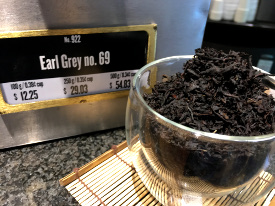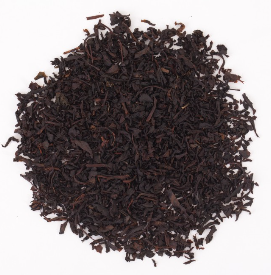Earl Grey no. 69: Love It or Hate It, It’s a Best-Seller


I sat down recently with Tin Roof Teas store manager and co-owner, Ryan Hinson, to talk about the love of Earl Grey teas, specifically Earl Grey no. 69. If you’ve never tried it before, or any Earl Grey for that matter, it has a cult following. Trust me. People feel strongly about it. Is it the bergamot? The catchy name? I’m digging in here, so read on to find out more!
First, let’s explore this most recognized flavor of tea. What is bergamot anyway? Bergamot can best be described as a citrus fruit the size of an orange and the color of a lime, which hails from a dwarf variety of the Seville orange tree.[1] But we don’t recommend taking a big bite… the “meat” of the fruit is beyond bitter; it’s only use for tea is the oil from the rind. As discussed in one of our previous blog posts, though, bergamot also provides some health benefits such as aiding in digestion, blood circulation and reducing nervous tension, stress, and anxiety. Who knew?! (can somebody go ahead and hook me up with an IV, please?)
*Fun Fact: Bergamot is the main export of Calabria, Italy,[2] which happens to be from where the Hinson family’s ancestors originated.*
Earl Grey. Say it to yourself. Earl. Grey. It’s strong, right? And memorable. So where did the name come from? The tea is named after the Prime Minister of England from 1830-1834, Earl Charles Grey. While it is not clear what exactly the Prime Minister did to receive such an honor, there are some likely and not-so-likely tales that have made their way through history. So for now, the jury is still out as to “why.”
At Tin Roof Teas, there are currently seven variations of Earl Grey offered, including three additional blends that are bergamot-esque. Of those, Earl Grey no. 69 is by far the most reputable with its Chinese, Indian, Ceylon black tea base. Earl Grey Rooibos (a caffeine-free, red tea) and Earl Grey Robusta (a stronger, Assam base) follow closely behind.
Admittedly, I was anti-bergamot for a really long time. It’s fine…we’ll take a minute to let everyone get their *gasps* out of the way. The taste was not appealing in the slightest, and the aroma was enough to make me hold my breath. It was so bad that I had difficulty even recommending an Earl Grey to tea drinkers because I couldn’t believe anyone actually liked the flavor. I know, I know. I’ve probably just offended the majority of you as mouths drop open, eyes are rolled, and scoffs are heard ‘round the world. Fear not, because there’s always a bright side! Oddly, after having my gallbladder removed, a strange thing happened. I discovered a love for many citrus things. And yes, that includes bergamot. Say what? Yep, I’ll say it again for the people in the back. My name is Jeannie and bergamot is my friend. From no. 69 to Robusta, Lady Violet to Earl Grey Cream, I enjoy them all. A lot. But since we’re here and this is fun, I’ll spark another controversial topic for another blog post. Are you ready? If I’m sipping on an Earl Grey, I must add milk/cream to my cuppa. There. I said it. I mean, is there really any other way?
Now that we are all subject-matter experts when it comes to Earl Grey teas, what say you? Are you part of the devoted following of Earl Grey no. 69? Or has one of our other blends captured your heart?
[1] https://en.wikipedia.org/wiki/Bergamot_orange
[2] https://www.liveabout.com/where-does-the-perfume-ingredient-bergamot-come-from-346207
This blog was written by Jeannie Hinson. In her spare time…wait, no. She doesn’t have any spare time. But she does love tea, and good laughs!

